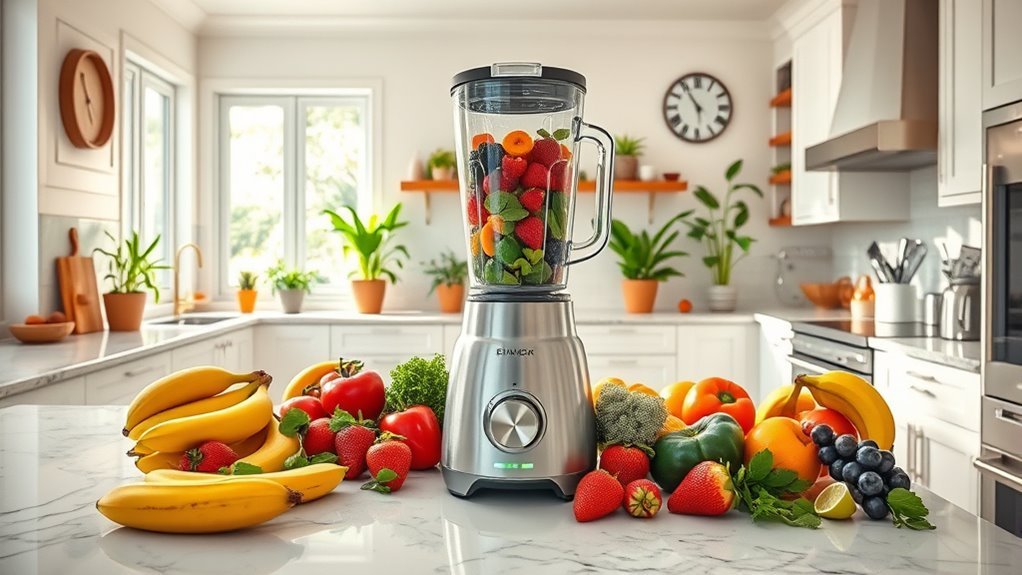Blender blade longevity comes down to three key factors we’ve tested extensively: material quality, engineering precision, and proper maintenance. Premium stainless steel and tungsten carbide blades maintain their edge longer due to superior hardness and wear resistance. Precision-engineered geometry, including ideal bevel angles and strategic serrations, dramatically reduces dulling. While proper cleaning and storage matter, it’s the combination of professional-grade materials and advanced design that truly sets long-lasting blades apart. Let’s explore what separates the champions from the challengers.
Material Quality and Edge Retention

When it comes to blender blade sharpness, material quality isn’t just a luxury – it’s the foundation of performance.
We’re seeing remarkable edge retention in blades crafted from premium materials like stainless steel and tungsten carbide. These aren’t your average kitchen metals – they’re engineered warriors against wear and corrosion.
Here’s what we’ve learned: blade design and material hardness work in perfect harmony. A harder metal keeps its edge longer, period.
But we’re not just talking about raw materials. The blade’s geometry, thickness, and bevel angle are critical factors in maintaining that razor-sharp edge.
Think of it as a precision instrument, not just a spinning metal contraption. When manufacturers nail the engineering specs and material quality, you get a blade that doesn’t just cut – it conquers. Additionally, blades in high-performance blenders are often designed to withstand the rigors of tougher ingredients, ensuring longevity and effectiveness.
Blade Design and Geometry Impact
The science behind blade geometry isn’t rocket science – it’s sharper. We’ve found that blade design and geometry directly impact cutting efficiency in ways that transform your blending experience.
When blade construction incorporates beveled edges and precise angles, you’re not just getting better cuts – you’re investing in longevity.
- Precision-engineered blade angles slash through ingredients with minimal resistance, keeping edges sharper longer
- Strategic serrations and bevels distribute force evenly, preventing premature dulling
- Optimized geometry means less wear on vital cutting surfaces, extending blade life
The marriage of smart geometry and proper construction isn’t just about initial sharpness – it’s about maintaining that edge through countless blends. High-performance blenders, with their enhanced versatility in the kitchen, leverage these advanced blade designs to deliver superior blending results.
We’re looking at designs that work smarter, not harder, leveraging physics to keep your blades razor-sharp.
Maintenance and Care Essentials

Since your blender’s blades can’t sharpen themselves, proper maintenance becomes your first line of defense against dullness.
We’ve seen countless blades fail prematurely from neglect, but you won’t make that mistake.
Let’s get practical: Clean those blades thoroughly after each use – no excuses.
Store your blender properly, and don’t let food residue cement itself onto the mechanisms.
We’re seeing remarkable durability improvements when users match blending speeds to ingredients (yes, that matters).
And please, stop crushing ice like you’re operating an industrial crusher – that’s a fast track to dull blades.
Watch for signs of declining sharpness and don’t wait until it’s too late for maintenance.
Trust us, high-quality stainless steel blades will reward your diligence with years of razor-sharp performance.
Usage Patterns and Longevity
Now that you’ve mastered basic maintenance, let’s talk hard facts about how you’re actually using those blades. Your usage patterns directly impact blade longevity, and we’re seeing too many people burn through expensive equipment unnecessarily.
Smart operation of powerful motors means consistent speeds and avoiding overload.
- Blending ice and frozen fruits? You’re accelerating blade wear faster than that morning smoothie ritual.
- Running your blender like it’s indestructible? That’s a quick path to dull blades and wasted money.
- Ignoring regular maintenance? Kiss that razor-sharp edge goodbye.
We’ll be blunt: sharpness retention comes down to material quality and how you treat your equipment.
High-grade stainless steel blades last longer, but even they need proper handling and regular maintenance to stay effective.
Professional Vs Consumer Grade Blades

When it comes to blade quality, you’ll find a stark difference between professional and consumer equipment that goes way beyond just the price tag.
Professional-grade blades use superior materials like stainless steel or tungsten carbide, delivering unmatched durability and edge retention.
We’re not just talking materials here. The cutting performance of professional blades stems from precision engineering – optimized angles, refined edges, and calculated thickness.
Consumer-grade blades often skimp on these essential design elements to cut costs. What’s more, professional units typically let you replace worn blades rather than junking the whole machine.
Think of it this way: pro blades are built to handle intense daily use without breaking a sweat, while consumer models might struggle with your morning smoothie marathon.
Optimal Storage and Handling Methods
Taking care of your blender blades starts with proper storage – and we’re not messing around here.
Let’s talk ideal storage and handling methods that’ll keep those blades razor-sharp. We’ve seen countless blenders die early deaths from improper care, but you’re not going to make those mistakes.
- Store blades in protective sheaths – it’s like giving your blades their own fortress against the chaos of your kitchen drawer.
- Handle with the respect they deserve – treat them like the precision instruments they are, not random utensils.
- Keep them bone-dry after cleaning – moisture is the enemy, and we’re waging war against corrosion.
Smart storage prevents dulling, and proper handling extends blade life.
Think of it as preventive maintenance – a few seconds of care now saves hours of frustration later.
Frequently Asked Questions
Why Do Some Knives Stay Sharp Longer?
Sharp as a tack, we’ll see knives keep their edge longer when they’re made with superior blade materials, feature ideal edge geometry, and we maintain them with proper maintenance techniques and sharpening tools.
How to Keep Blender Blades Sharp?
We’ll keep our blender blades sharp through regular blade maintenance tips: clean after each use, avoid hard materials, employ proper sharpening techniques, and use correct quantities when blending to prevent wear.
Do Egg Shells Really Sharpen Blender Blades?
We’ve found egg shell effectiveness in sharpening blender blades is modest at best. While they can help maintain blades through gentle abrasion, proper blender maintenance tips and blade material comparison matter more.
Does Ice Actually Sharpen Blender Blades?
We need to dispel sharpening myths: ice actually damages blender blades, not sharpens them. The ice effects create wear on blade materials, making grinding methods less effective over time.

